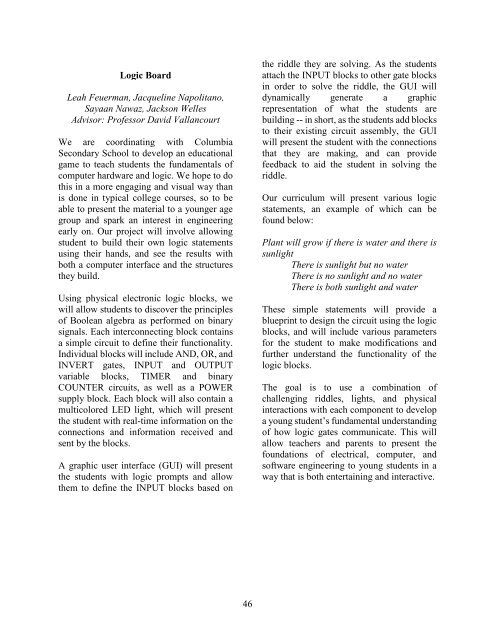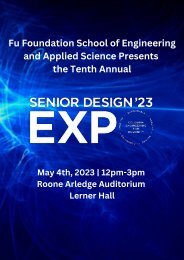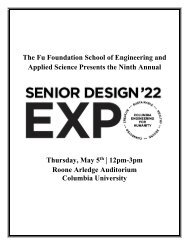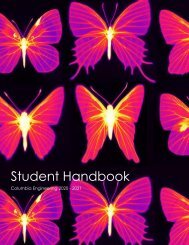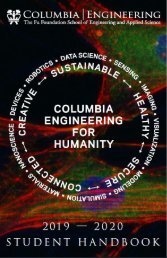Senior Design Expo 2019
The Senior Design Expo, held annually in May at Columbia University, is an opportunity for Columbia Engineering students to showcase what they have learned in their foundational math and science courses together with their engineering courses in innovative, creative, and purposeful designs and prototypes. Each year the Expo showcases more than 60 projects across all nine departments. Projects have included cutting-edge robotics, the New York City subway system, language technology, proposals for bridges to span the Hudson river, and much more.
The Senior Design Expo, held annually in May at Columbia University, is an opportunity for Columbia Engineering students to showcase what they have learned in their foundational math and science courses together with their engineering courses in innovative, creative, and purposeful designs and prototypes. Each year the Expo showcases more than 60 projects across all nine departments. Projects have included cutting-edge robotics, the New York City subway system, language technology, proposals for bridges to span the Hudson river, and much more.
Create successful ePaper yourself
Turn your PDF publications into a flip-book with our unique Google optimized e-Paper software.
Logic Board<br />
Leah Feuerman, Jacqueline Napolitano,<br />
Sayaan Nawaz, Jackson Welles<br />
Advisor: Professor David Vallancourt<br />
We are coordinating with Columbia<br />
Secondary School to develop an educational<br />
game to teach students the fundamentals of<br />
computer hardware and logic. We hope to do<br />
this in a more engaging and visual way than<br />
is done in typical college courses, so to be<br />
able to present the material to a younger age<br />
group and spark an interest in engineering<br />
early on. Our project will involve allowing<br />
student to build their own logic statements<br />
using their hands, and see the results with<br />
both a computer interface and the structures<br />
they build.<br />
Using physical electronic logic blocks, we<br />
will allow students to discover the principles<br />
of Boolean algebra as performed on binary<br />
signals. Each interconnecting block contains<br />
a simple circuit to define their functionality.<br />
Individual blocks will include AND, OR, and<br />
INVERT gates, INPUT and OUTPUT<br />
variable blocks, TIMER and binary<br />
COUNTER circuits, as well as a POWER<br />
supply block. Each block will also contain a<br />
multicolored LED light, which will present<br />
the student with real-time information on the<br />
connections and information received and<br />
sent by the blocks.<br />
A graphic user interface (GUI) will present<br />
the students with logic prompts and allow<br />
them to define the INPUT blocks based on<br />
the riddle they are solving. As the students<br />
attach the INPUT blocks to other gate blocks<br />
in order to solve the riddle, the GUI will<br />
dynamically generate a graphic<br />
representation of what the students are<br />
building -- in short, as the students add blocks<br />
to their existing circuit assembly, the GUI<br />
will present the student with the connections<br />
that they are making, and can provide<br />
feedback to aid the student in solving the<br />
riddle.<br />
Our curriculum will present various logic<br />
statements, an example of which can be<br />
found below:<br />
Plant will grow if there is water and there is<br />
sunlight<br />
There is sunlight but no water<br />
There is no sunlight and no water<br />
There is both sunlight and water<br />
These simple statements will provide a<br />
blueprint to design the circuit using the logic<br />
blocks, and will include various parameters<br />
for the student to make modifications and<br />
further understand the functionality of the<br />
logic blocks.<br />
The goal is to use a combination of<br />
challenging riddles, lights, and physical<br />
interactions with each component to develop<br />
a young student’s fundamental understanding<br />
of how logic gates communicate. This will<br />
allow teachers and parents to present the<br />
foundations of electrical, computer, and<br />
software engineering to young students in a<br />
way that is both entertaining and interactive.<br />
46


